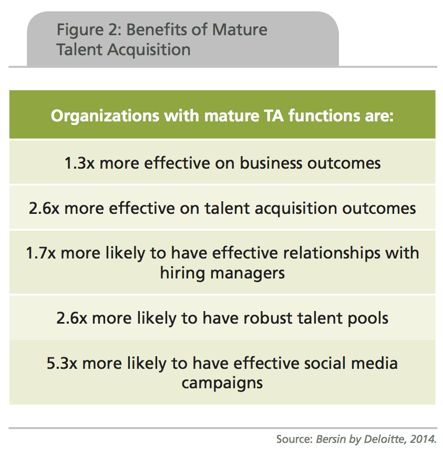At face value, talent acquisition might seem obvious, straightforward and handled from an organisational perspective. After all, organisations hire employees every day, and have been doing so for a long, long time. However, as the way we work continues to evolve, the talent acquisition function has become a highly complex and dynamic process. With multiple types of employees, many performance drivers, ever-evolving technology, a plethora of solution and service providers, and a shortage of great talent, the importance of acquisition cannot be overstated.
According to Bersin's research, talent acquisition leaders need to 'embrace technology like never before, adopt modern approaches to sourcing, and achieve metrics that are often hard to measure.' All this is crucial, while also maintaining strong partnerships across the organisation and staying aligned with business strategy. Bersin's research also reveals key performance drivers that can accelerate your organisation’s capabilities in acquiring top-tier talent.
The Talent Acquisition Maturity Model
Bersin's high impact talent acquisition research lead to the development of a 4 level maturity model. Each level of the model is defined as follows:
Level 1: Reactive Tactical Recruiting
At this level, candidates are sourced on an as-needed basis across business units. Level 1 recruiters function primarily as order-takers for hiring managers and positions are posted on an as-needed basis. Hiring processes are not well defined, minimal hiring standards are adhered to, and there is no strategic focus on candidate experience.
Level 2: Standardised Operational Recruiting
At this level, processes and technology are standardised across the organisation. Recruiters are beginning to develop strong relationships with hiring managers and typically have an effective assessment framework to measure candidates against job requirements. Here, organisations are beginning to manage their employment brand and to define an employee value proposition.
Level 3: Integrated Talent Acquisition
Here the talent acquisition function is fully integrated with the HR and talent management functions. Level 3 organisations tend to have effective social media campaigns and powerful employment brands, as well as robust acquisition programs in place, including alumni networks and formalised employee referral programs.
Level 4: Optimised Talent Acquisition
At this level, the talent acquisition function is considered to be a strategic enabler and partner within the business. The strategic focus of Level 4 organisations centers on forecasting external forces and remaining agile. These organisations are also committed to investing in new acquisition products and services to stay competitive.

What Leaders Should Know About Talent Acquisition
Bersin's research has uncovered several benefits associated with developing the maturity of your organisation’s talent acquisition function. A short list of their top four findings is outlined below:
- High-impact talent acquisition improves overall business and talent acquisition performance outcomes. Bersin's research indicates that the most mature (or Level 4) talent acquisition functions perform, on average, 1.3 times (or 30 percent) better on business outcomes than organisations at Level 1, making the business case for investment in talent acquisition very compelling. In addition, Level 4 organisations are 2.6 times (or 160 percent) more likely to achieve higher talent acquisition performance outcomes as compared with organisations at Level 1.
- Developing strong relationships with hiring managers is the top driver of talent acquisition performance. Bersin's research shows that this is the top driver of talent acquisition performance, and is four times more influential than the other performance drivers (out of 16 discussed in their main report). The impact of effective hiring manager relationships can be realised not only through smarter hiring decisions and increased productivity, but also with the greater perception of talent acquisition as a whole in the organisation.
- Candidate pool development is the second most influential talent acquisition performance driver. This is two times more influential than the remaining performance drivers. Developing robust candidate pools should be top of mind for recruiters, as they are tasked with providing 'just-in-time' candidates, as well as future talent programs.
- A strategic social media campaign is a significant differentiator for companies at the highest level of maturity. Social media in talent acquisition remains a key consideration for talent acquisition leaders as the third most influential core performance driver. Mature talent acquisition functions are approximately five times more likely to have effective social media campaigns than organisations at the lowest level of maturity.
Bersin's research on talent acquisiton highlights the importance of approaching the attraction of talent in the same way that your business would approach the acquisition of customers. The last few years have seen an explosion of content across the digital landscape, particularly that focused on attracting, converting, closing and delighting customers. One has to ask the question - when are HR Professionals going to turn their attention to creating the same kind of digital content aimed at attracting, converting, closing and delighting talent?
Want to learn more about how Subscribe-HR's software can help you create passive talent pools - which Bersin identifies as the second most influential acquisition performance driver? Start your free trial and test drive our HR solutions from the comfort of your desk.


